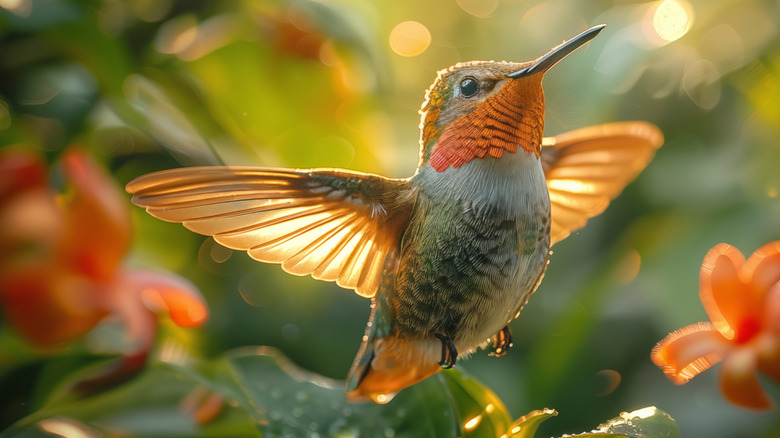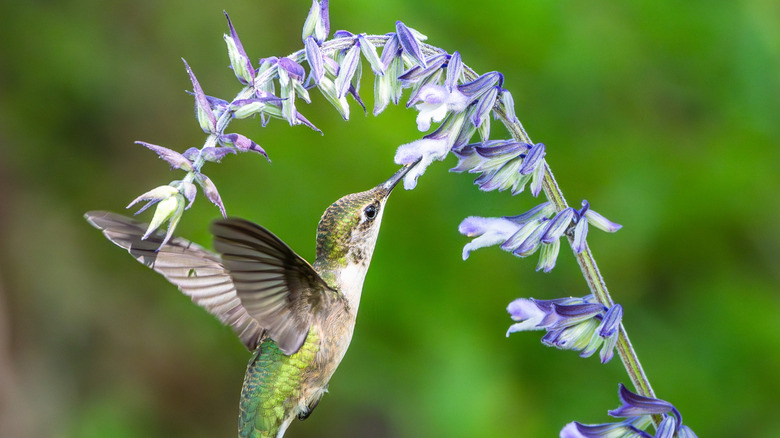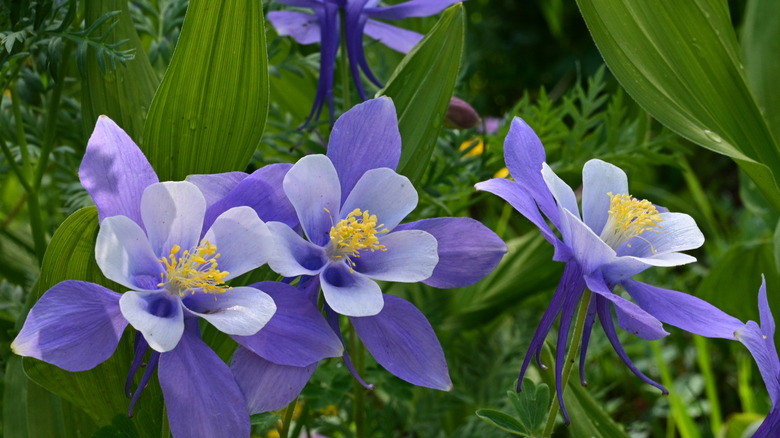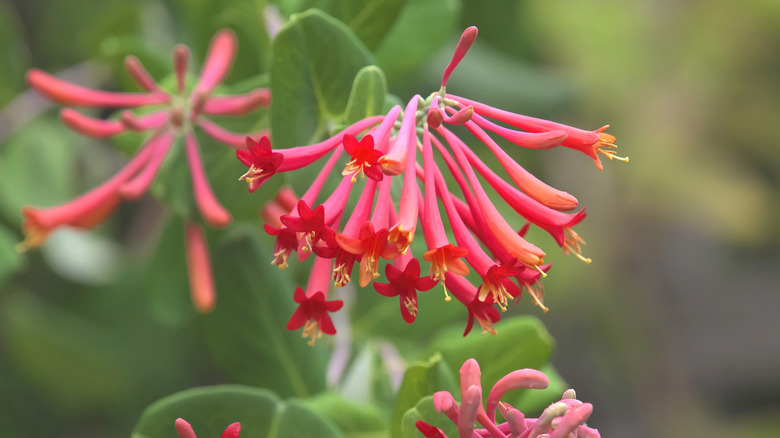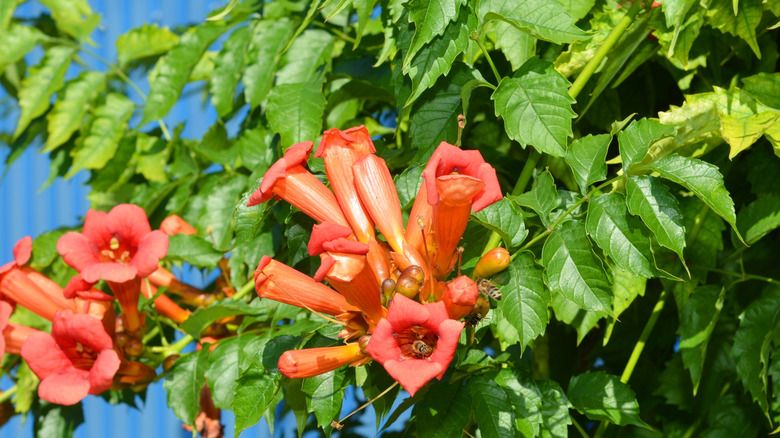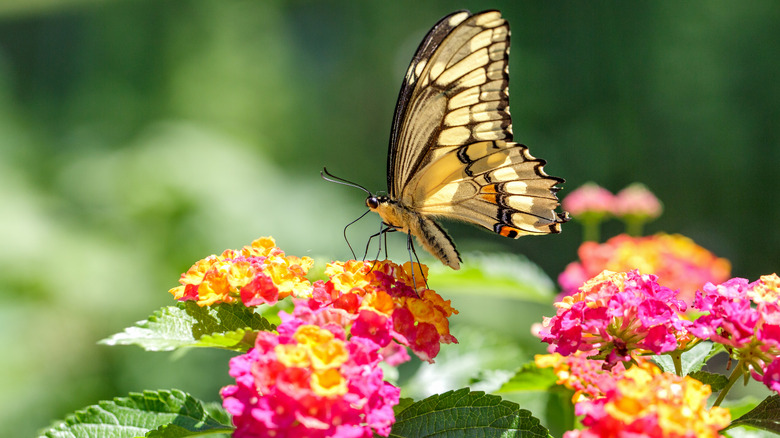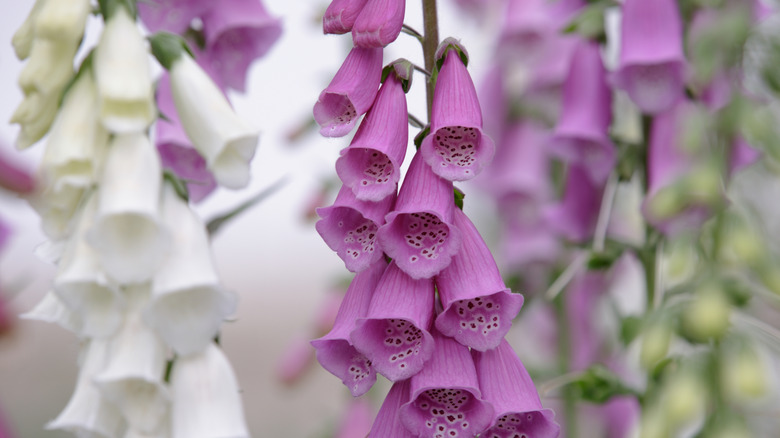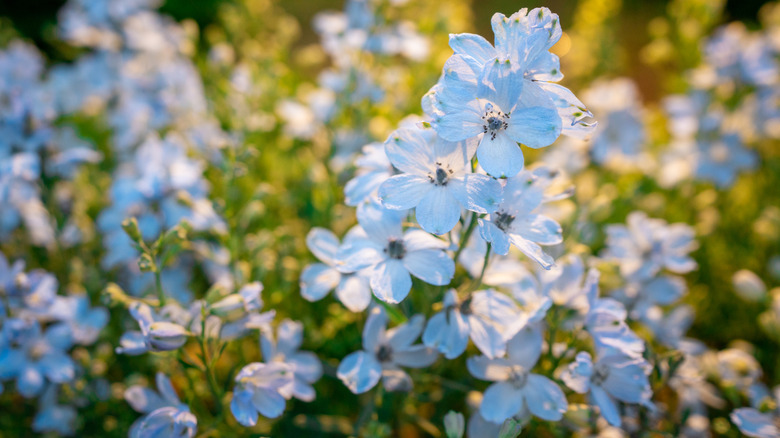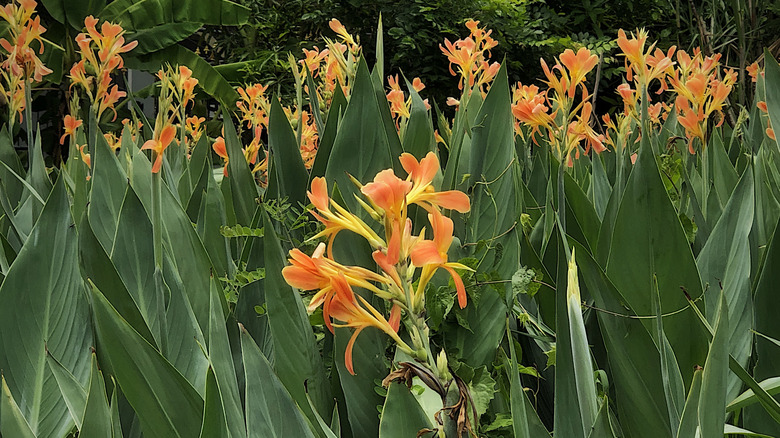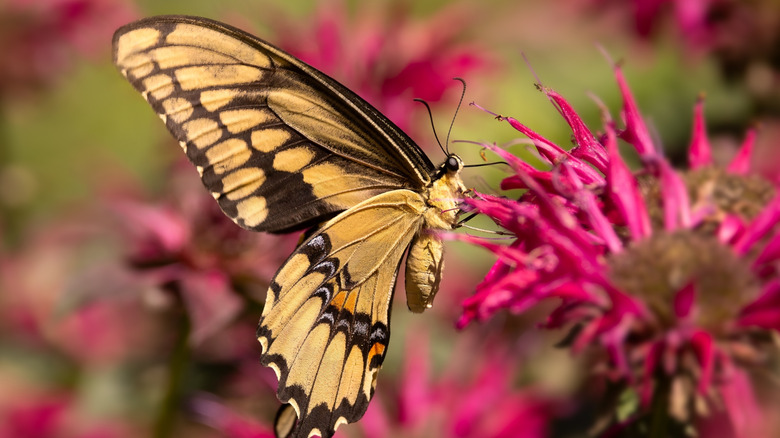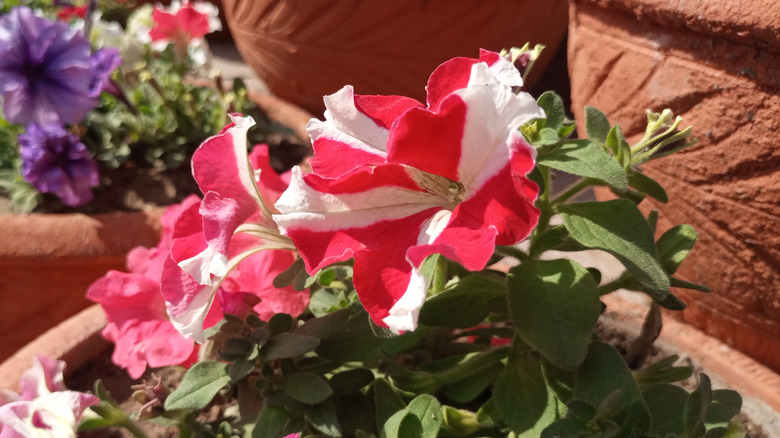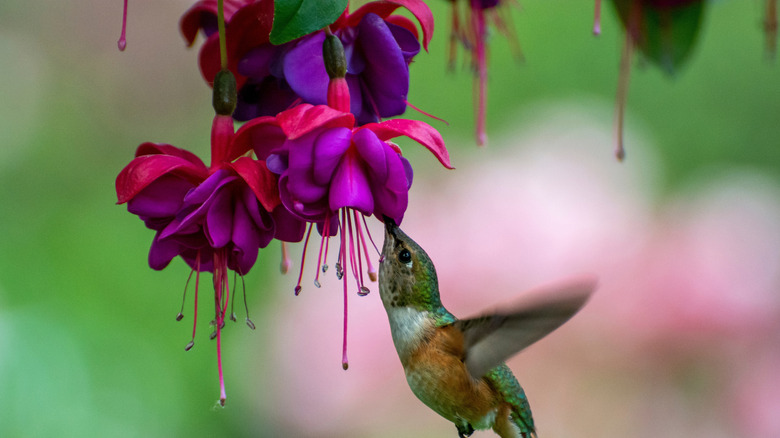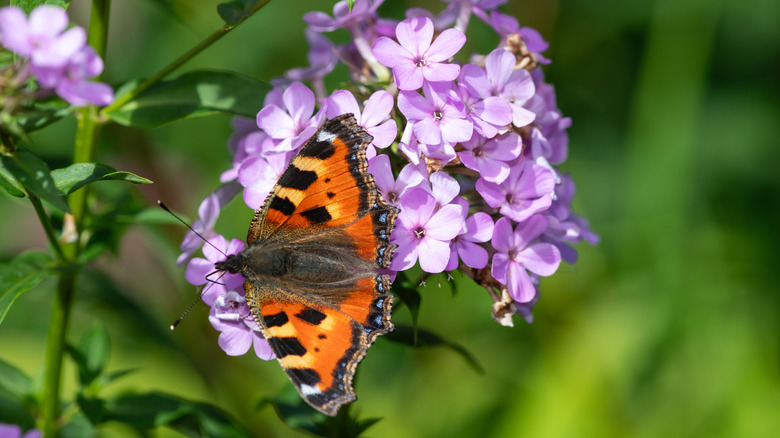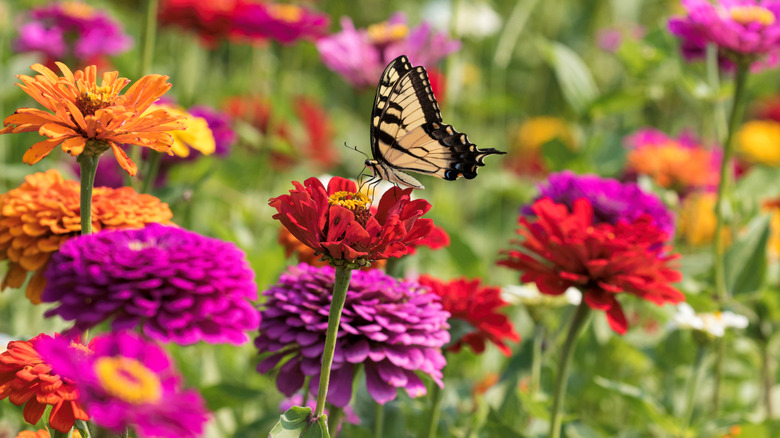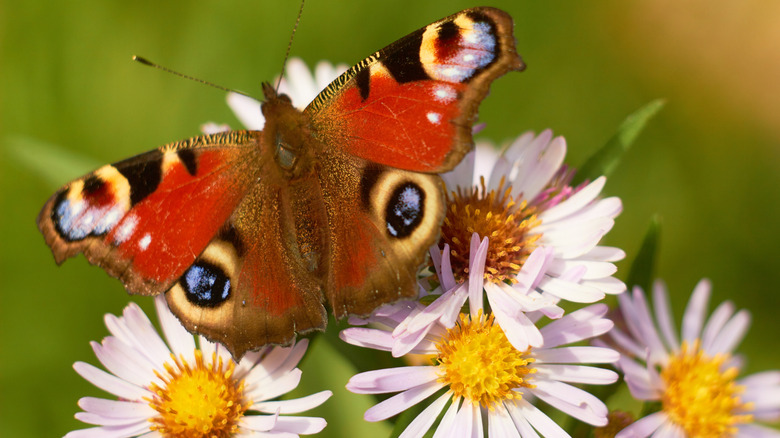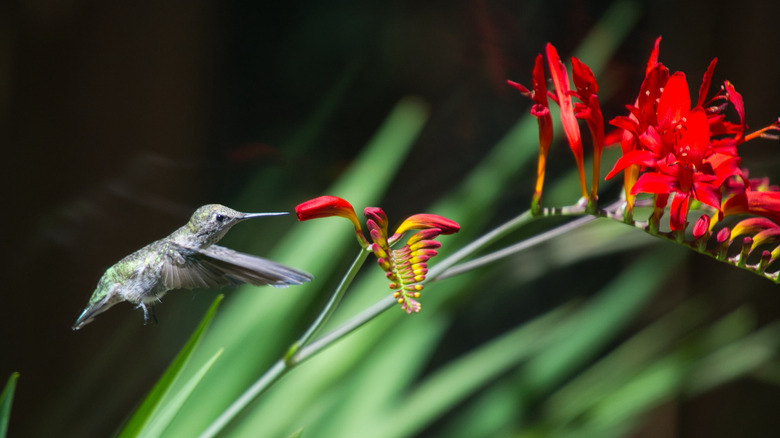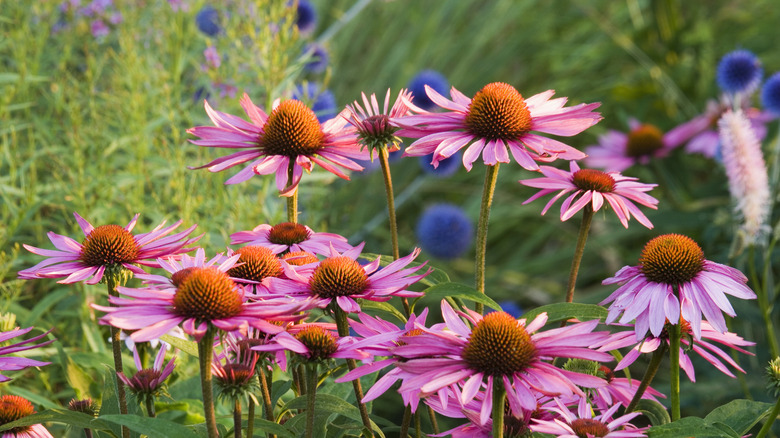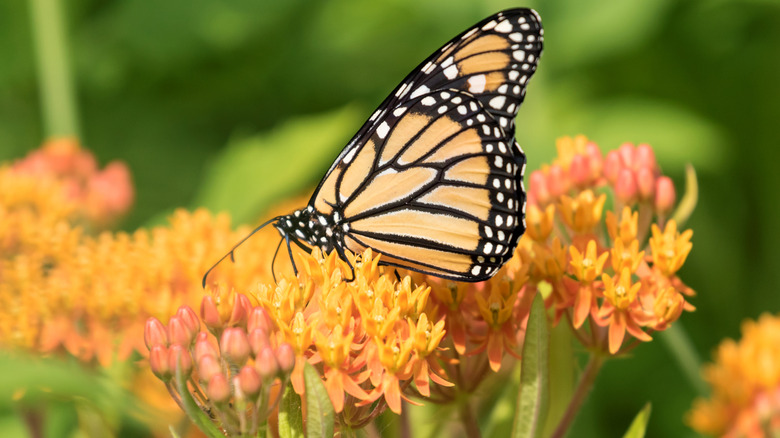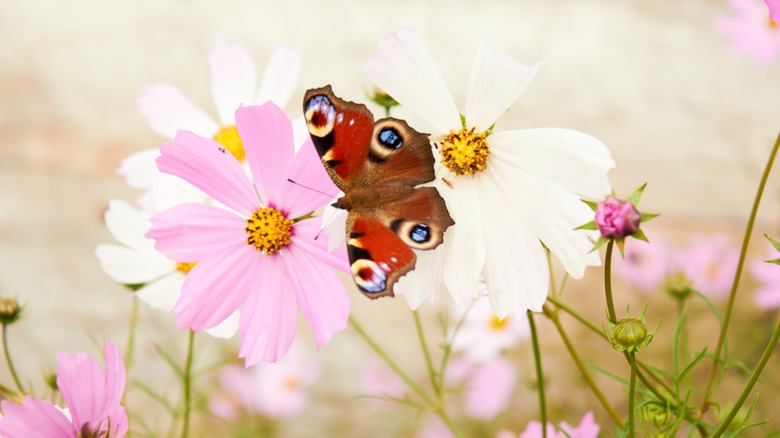18 Plants That Will Attract Both Hummingbirds & Butterflies To Your Yard
A mere win is pretty good. A win-win situation is even better, but a win-win-win resulting from gorgeous flowers that attract hummingbirds and butterflies (and, usually, bees) seems just plain greedy. But since everyone wins, why not embrace the greed and seek out flowers for your garden that enrich the lives of just about any creature that passes by? Except deer and rabbits, of course. Attention-getting, nectar-rich flowers attract people and pollinators, which then do their part for the plant's survival. Growing asters, zinnias, columbine, coppertips, coneflowers, and more is a garden plan that works for everyone.
Conventional wisdom says that nectar- and pollen-rich red, tubular flowers are your best bet for hummers and butterflies, and although there's some truth to that, we'll see there are way more options available to you. And there's a bit more to beneficial spaces than mere plant selection. A hummingbird- and butterfly-friendly garden will have a few other characteristics you shouldn't ignore, like avoiding pesticides, especially on a plant's blooms. You should also consider providing water and supplemental nutrition with feeders, birdbaths, and the like. You may even want to consider putting a comfy chair nearby. The butterflies and hummingbirds don't need it, but the more you enjoy their visits, the more you'll continue to choose flowers for them — and that's a win-win-win for everyone.
1. Salvia
You have to be invited to the salvia party. It has evolved a natural resistance to rabbits and deer, but honeybees, hummingbirds, and butterflies are welcome anytime. While the best flowers for butterflies and hummers are often red or orange, the purple and blue salvias like the Henry Duelberg and Mystic Spires Blue varieties often win the day. Of course, red varieties like Firelight and Scarlet Sage do a great job, as well. Monarch and fritillary butterflies often prefer the larger blooms of varieties like Saucy Red and Saucy Wine.
2. Columbine
You probably won't have any trouble growing columbine in your garden, and the hummingbirds and butterflies probably won't have any trouble finding it. Another deer- and rabbit-resistant native, columbine freely self-seeds and hybridizes, so the number of colors available are vast, and hummingbirds and butterflies seem to enjoy most of them. Deadheading encourages more blooms (at the expense of the seeds for next year's volunteers, of course). Though they often over-winter, columbine doesn't last more than a couple of seasons, but they self-seed so aggressively that they offer the appearance of thriving perennials.
3. Honeysuckle
When Henry Reed wrote in his poem "Naming of Parts" that "Japonica glistens like coral in all of the neighbouring gardens," he was probably talking about Japanese quince, but in the New World he might as easily have been talking about Japanese honeysuckle, and the hummingbirds and butterflies would agree. Beneficials are drawn in by the tubular shape and appealing colors of honeysuckle, but you might be better off glistening like a different coral... say, Lonicera sempervirens, also known as coral honeysuckle or trumpet honeysuckle, rather than the invasive Japonica.
4. Trumpet Vine
Just as you won't have trouble encouraging columbine or honeysuckle to grow, trumpet vine also wants to be in your garden. And in your neighbor's garden. And in their neighbors' yards, and possibly their shoes if they're still too long. Butterflies and hummingbirds, in turn, want to be where these flowers are. These beauties take three to five years to form their first blooms, but when they come, be prepared for the explosion of flowers from June to September. This plant is invasive in some regions, so check to make sure it's not considered invasive where you live.
5. Lantana
Over on the sunny side of your garden, lantana attracts butterflies and hummingbirds to its nonstop blooms. As a perennial in warmer areas, lantana can grow 5 feet wide and even taller than that, but even as a cool-weather annual this plant still thrives... just a little closer to the ground. Lantana can be invasive in some areas, so look for certified sterile varieties. Trailing lantana like Bandolista Red Chili are great in hanging baskets. Lantana is instantly recognizable and is one of a handful of plants you'll find in basically any butterfly garden.
6. Foxglove
As tubular flowers are usually a giveaway that hummingbirds and butterflies will enjoy them, you can probably predict that the tall spires of vividly colored foxgloves blooms will draw tons of them to your yard or garden. Foxgloves are available in an enormous array of colors and do well in just about any amount of sun. They also grow well in containers. They are very poisonous to people and pets, so keep an eye on any loved ones wandering near foxgloves. They usually bloom in early summer, but you can extend the season with judicious pruning.
7. Delphinium
If spires of startling color are your thing and you're not put off by its toxicity, delphinium (larkspur) is another gorgeous full-sun addition to your garden. Hummingbirds and butterflies both love the early-summer blooms of this herbaceous perennial. Delphinium flowers tend to be blues and purples. They've been hybridized to reach a variety of heights, with some varieties reaching 6 feet or more. Stake the plants when they reach about a foot in height. Because it is extremely toxic to most animals, deer and rabbits steer clear of it.
8. Canna
Classic canna lilies are dramatic flowers that grow to 3- to 5-feet-tall, or you can opt for 2-foot dwarf varieties. These plants need full sun and plenty of water. In return you'll get the devotion of nearby hummingbirds and butterflies. Blooms are typically orange or red, show up mid- to late-summer, and last three to four months. Cannas are hearty in zones 7 to 11, but you can store rhizomes indoors in colder climates. They even host a butterfly, the canna leafroller, though its more moth-like coloration is probably not what you had in mind when you read "butterfly."
9. Beebalm
Beebalm was used by the Oswego and Oneida nation people as a medicinal plant to treat bee stings before Europeans arrived in the western hemisphere, which became kind of a self-fulfilling prophecy since the plant attracts bees so readily. This lovely mint, also known as wild bergamot, is just as adept at attracting hummingbirds and butterflies. American colonialists reportedly drank tea made from bee balm after the Boston Tea Party deprived them of their usual tea, but note that wild bergamot is not where Earl Grey gets its flavor. That bergamot comes from orange peel.
10. Petunia
Petunias are often a shortcut ... not because you're taking the easy way out, but because they're the quickest way to get where you want to be with a flower bed or garden container. They bloom brilliantly for practically the entire growing season, and are very easy to care for. And because they work so well in hanging baskets, nectar-rich petunias are particularly good for hummingbirds. You get a lot of blooms and a lot of butterflies and hummers. They're heat-tolerant and enjoy full sun. Some varieties will require more water and fertilizer than others.
11. Fuchsia
Fortunately for us, and our hummingbird and butterfly friends, fuchsia is easier to grow than it is to spell. Hummingbirds, in particular, are drawn to these two-tone wonders. Bella Fuchsia, in a remarkable bit of phraseology that either misunderstands evolution or understands love better than the rest of us, "Fuchsia plants and hummingbirds have built an evolutionary love affair." Because you plant flowers for yourself as well, it's worth noting that fuchsia blooms are remarkable from any angle. Considering the 100+ varieties out there, the unbelievable number of ways to see beauty in fuchsia is exceptional.
12. Phlox
Creeping phlox is what the ground would look like if hummingbirds designed it. Older cultivars start blooming in mid to late summer and show off for six weeks or so. Some newer varieties will bloom earlier. The ground cover attracts hummingbirds, butterflies, and other pollinators to its showy, nectar-rich, and often scented smorgasbord. It's low to the ground, obviously, but Phlox paniculata, commonly called "tall phlox," will grow up to 5 feet tall. Since there are many species of varying heights, you can probably find a cultivar that perfectly fits your garden.
13. Zinnia
Zinnias are available in a wider collection of varieties than most flowers – tall and short with various growth habits and single, semi-double, or double petals. One flower grows on each stem, so that when you get bored with the abundance of butterflies and hummingbirds they draw to your garden, you can cut the flowers for floral arrangements to enjoy indoors where the pesky critters can't bother you. (We kid!) The heavy blooms are prone to bending stems, so it's usually a good idea to stake them. These annuals are very prolific and thrive in full sun.
14. Aster
Asters are what Bob Ross — and pretty much anyone else — would have to call "happy little flowers." There are 250 varieties of these tall, late summer/early fall bloomers split between one to three genera, depending who you ask. Their white or yellow central florets encircled with various colors of ray petals are irresistible to butterflies, bees, and hummingbirds. For many gardens, these late-season bloomers are a final blast of color before the drabness of late fall and winter begin in earnest. The hummers and butterflies will surely appreciate it, too.
15. Coppertips
One close-up look at coppertips (Crocosmia), and you know immediately that the hummingbirds and butterflies will dig it. Their flower stalks sometimes look like nothing so much as a diving board full of tubular honeysuckles crowding the hesitant diver at the end. The foliage and flower stalks from these bulb-like corms grow up to be slightly unusual but very rewarding late-summer to early-fall showoffs. Overcrowding and using too much fertilizer can cause coppertips to fail to bloom, and while the flowerless foliage is striking, it certainly won't attract hummers and butterflies, so look after them a bit carefully.
16. Coneflower
First, a funny line that will help you remember coneflower's other name. "Is it possible I'm taking something called euthanasia?" asked the president in "The West Wing." He was, of course, thinking of echinacea, which is what coneflower is commonly called when discussing its medicinal benefits. These lovely blooms, which look like daisies that are living a little too fast, can command the attention of hummers and butterflies during their blooming season from June to August. They're not particular — just a bit of water now and then — but be sure to deadhead them regularly to keep the blooms going.
17. Butterfly Weed
Butterfly weed (Asclepia tuberosa) is a native wildflower in the milkweed family that's native to much of the U.S. Its blooms attract butterflies and hummingbirds most of the growing season. Butterfly weed, being a native (and a "weed," no less) is virtually effortless, and is hardy in USDA hardiness zones 3 to 9. While some tropical varieties of milkweed have a reputation for harming monarch butterflies, butterfly weed is okay for monarchs anywhere outside of their California overwintering areas. It might be a late-bloomer the first year, but should bloom throughout summer and fall after that.
18. Cosmos
It's inexplicable that cosmos has recently fallen out of fashion, in spite of being beautiful as well as a quick and easy to grow flower for beginner gardeners. So easy, in fact, that the Georgia Department of Transportation seeded it alongside the state's roadways for its pretty blooms and pollinator support. This annual self-seeds so vigorously that cosmos essentially becomes a perpetual wash of blooms for mile after mile. Native everywhere in the U.S. except the northwest, cosmos are great for edible gardens, flower gardens, roadsides ... and, of course, for hummingbirds and butterflies.
